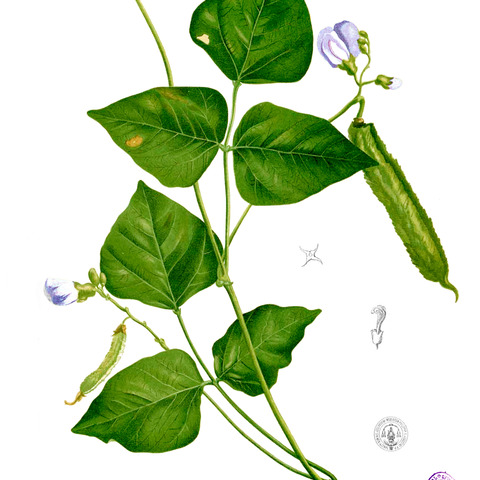Herbs, climbing or prostrate, rarely erect, with tubers. Leaves pinnately 3-foliolate; stipules produced below point of insertion; leaflets stipellate. Flowers solitary or in axillary racemes with swollen nodes. Bracts small, very caducous; bracteoles larger, membranous, persistent for a time. Calyx 5-toothed, 2 upper teeth connate into entire or bifid lip. Corolla lilac or violet, exserted from calyx; standard suborbicular, appendaged with basal auricles; wings obliquely obovate; keel incurved at apex, obtuse. Vexillary stamen free at base, connate with tube in middle; anthers uniform, 5 basifixed alternating with 5 dorsifixed. Ovary shortly stipitate; ovules 3-21; style incurved; stigma globose, densely penicillate-villous. Legumes oblong, 4-winged lengthwise, septate between seeds. Seeds ovate or oblong-elliptic, with or without aril.
Ovary stipitate; ovules 3–many; style thickened above the ovary, bent, flattened towards the apex, bearded longitudinally or with a ring of hairs below the stigma; stigma terminal or subterminal, penicillate or not.
Calyx 5-lobed, the upper pair of lobes fused for all or part of their length; lower lobes various.
Leaves pinnately 3-foliolate; stipules appendaged below the point of insertion; stipels present.
Inflorescence an axillary pseudoraceme, subumbel or umbel; bracts and bracteoles present.
Seeds ovoid, oblong or square, brown to black or deep purple, with or without an aril.
Stamens 10, 9 with filaments fused, 1 free to the base or connate in the middle.
Corolla mostly blue or mauve, rarely yellow; standard auriculate, appendaged.
Fruit narrowly cylindrical, 4-winged, septate, dehiscent.
Herbs or subshrubs, prostrate or climbing, rarely erect.

